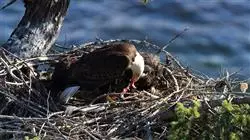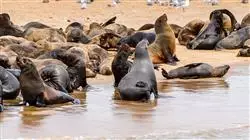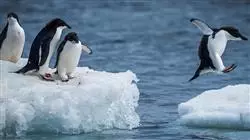University certificate
The world's largest faculty of veterinary medicine”
Introduction to the Program
Do not miss the opportunity to take this Master's Degree in Wildlife Management with us. It's the perfect opportunity to advance your career”

The Master's Degree in Wildlife Management is a broadly specialized program with an inherent coherence to its structure, which allows specialization in the main disciplines related to wildlife conservation.
It addresses all the fundamental concepts that form the necessary ecological basis on which to build throughout the syllabus. In addition, it defines the fundamental international regulatory framework for biodiversity conservation.
It analyzes one of the main threats to biodiversity loss i.e., invasive alien species, establishing the main lines of action to manage them.
It examines how to monitor wildlife through direct or indirect observations, such as droppings, nests, pellets and other natural signs of wildlife, analyzing the main census methods used for fundamental species when developing wildlife monitoring programs.
It also addresses hunting management as one more piece of the puzzle in the treatment of wildlife and conservation, so the objective to be achieved will be to carry out a sustainable use of resources, setting rhythms that do not lead to the decrease of biological diversity in the long term while integrating other uses into the environment.
At the same time, it presents all the relevant aspects to estimate livestock burdens placed on the environment and to determine quotas to establish sustainable hunting management. It will also determine the main factors to analyze and incorporate when making a correct Technical Hunting Plan.
It analyzes the regulatory framework of wildlife diseases in detail, as well as action protocols in case of signs or suspicion of the main diseases associated with wildlife.
This Master's Degree provides specialized knowledge to perform an in-depth statistical analysis. All this is defined from a theoretical point of view in the first place, to be subsequently developed through Statistica software.
The program covers Distance software, the most widely used computer program to analyze wildlife sampling data, developing the necessary sections for data import, analysis configuration and validation of results.
Moreover, the territorial management of species is not an issue linked to field interpretation and management. Species distribution data are increasingly analyzed from a technological perspective in the office. The inclusion of teaching units based on technologies, such as geographic information systems, is useful to represent field data graphically and interpretatively through maps.
Specialize with us and learn the concepts associated with wildlife populations and the processes and interactions that take place”
This Master's Degree in Wildlife Management contains the most complete and up-to-date scientific program on the market. The most important features include:
- Case studies presented by experts in Wildlife
- The graphic, schematic, and practical contents with which they are created, provide scientific and practical information on the disciplines that are essential for professional development
- New developments in Wildlife Management
- Practical exercises where the self-assessment process can be carried out to improve learning
- Special emphasis on innovative methodologies in Wildlife Management
- Theoretical lessons, questions for experts, discussion forums on controversial issues and individual reflection work
- Content that is accessible from any fixed or portable device with an Internet connection
This Master's Degree is the best investment you can make in the selection of an updated program in Wildlife Management”
Its teaching staff includes professionals belonging to the veterinary field, who contribute their expertise to this specialization, as well as renowned specialists from leading societies and prestigious universities.
The multimedia content, developed with the latest educational technology, will provide the professional with situated and contextual learning, i.e., a simulated environment that will provide immersive specialization programmed to learn in real situations.
This program is designed around Problem-Based Learning, whereby the specialist must try to solve the different professional practice situations that arise throughout the program. For this purpose, the professional will be assisted by an innovative, interactive video system created by renowned and experienced experts in Wildlife Management
This program comes with the best educational material, providing you with a contextual approach that will facilitate your learning"

This 100% online Master's Degree will allow you to combine your studies with your professional work while increasing your knowledge in this field"
Syllabus
The content has been structured and designed by leading professionals in Wildlife Management, who have extensive experience and recognized prestige in the profession, backed by the volume of cases reviewed, studied, and diagnosed, and who have extensive knowledge of new technologies applied to veterinary medicine.

We have the most complete and up-to-date academic program in the market. We strive for excellence and for you to achieve it too"
Module 1. Fundamentals of Ecology
1.1. General Ecology I
1.1.1. Reproduction Strategies
1.1.2. Biological Indicators
1.1.2.1. Productivity
1.1.2.2. Sex Ratio
1.1.2.3. Flight Rate
1.1.2.4. Operational Birth Rate
1.1.2.5. Reproductive Success
1.2. General Ecology II
1.2.1. Birth Rate and Mortality
1.2.2. Growth
1.2.3. Density and Assessment
1.3. Population Ecology
1.3.1. Gregariousness and Territorialism
1.3.2. Feeding Area
1.3.3. Activity Patterns
1.3.4. Age Structure
1.3.5. Predation
1.3.6. Animal Nutrition
1.3.7. Extinction: Critical Periods
1.4. Biodiversity Preservation
1.4.1. Life Cycle Critical Periods
1.4.2. International Union for Conservation of Nature (IUCN) Categories
1.4.3. Conservation Indicators
1.4.4. Vulnerability to Extinction
1.5. Surrogate Species I
1.5.1. Keystone Species
1.5.1.1. Description
1.5.1.2. Real Examples
1.5.2. Umbrella Species
1.5.2.1. Description
1.5.2.2. Real Examples
1.6. Surrogate Species II
1.6.1. (Flagship Species)
1.6.1.1. Description
1.6.1.2. Real Examples
1.6.2. Indicator Species
1.6.2.1. Biodiversity Status
1.6.2.2. Habitat Status
1.6.2.3. Population Status
1.7. Plant Ecology
1.7.1. Plant Successions
1.7.2. Animal-Plant Interaction
1.7.3. Biogeography
1.8. Ecosystems
1.8.1. Structure
1.8.2. Factors
1.9. Biological Systems and Communities
1.9.1. Community
1.9.2. Structure
1.9.3. Biomass
1.10. Energy Flows
1.10.1. Nutrient Cycles
Module 2. Regulatory Bases in Species Conservation
2.1. Convention on Biological Diversity
2.1.1. Mission and Objectives
2.1.2. Strategic Plan for Biological Diversity
2.2. Convention on International Trade in Endangered Species of Wild Fauna and Flora
2.2.1. Structure and Objectives
2.2.2. Appendices I, II and III
2.3. Ramsar Convention
2.3.1. Structure and Objectives
2.3.2. Designation of Ramsar Sites
2.4. Other International Conventions
2.4.1. United Nations Convention to Combat Desertification
2.4.2. Bonn Convention on the Conservation of Migratory Species
2.4.3. OSPAR Convention
2.5. Berna Convention
2.5.1. Structure and Objectives
2.6. South America: National Strategies for Biodiversity
2.6.1. Mission and Objectives
2.6.2. Main Lines of Action
Module 3. Wildlife Management
3.1. Management of Protected Natural Areas
3.1.1. Introduction
3.1.2. Structure
3.1.3. Restrictions
3.2. Management of Endangered Species Conservation
3.2.1. Action Plans
3.2.2. Recovery Plans
3.3. Forest Management
3.3.1. Forest Planning
3.3.2. Management Projects
3.3.3. Main Overlap between Forestry Management and Species Conservation
3.4. On-Site Management
3.4.1. Actions on the Habitat
3.4.2. Actions on Prey and Predators
3.4.3. Actions on Diet
3.5. Off-Site Management
3.5.1. Captive Breeding
3.5.2. Reintroductions
3.5.3. Translocations
3.5.4. Recovery Centers
3.6. Invasive Alien Species (IAS) Management
3.6.1. Strategies and Plans
3.7. Management Tools: Access to Information
3.7.1. Data Sources
3.8. Management Tools: Strategies
3.8.1. Main Lines
3.8.2. Strategies against the Main Threats
Module 4. Wildlife Census
4.1. Introduction to Observation Methods
4.1.1. Direct Observation
4.1.2. Signs
4.1.2.1. Direct Signs
4.1.2.2. Indirect Signs
4.1.3. Electric Fishing
4.2. Indirect Signs: Natural Signs I
4.2.1. Natural Signs
4.2.1.1. Tracks
4.2.1.2. Paths and Steps
4.2.1.3. Droppings and Pellets
4.3. Indirect Signs: Natural Signs II
4.3.1. Sleeping Sites, Beds and Burrows
4.3.2. Territorial Markings
4.3.3. Moults, Hairs, Feathers and Other Remains
4.4. Indirect Signs: Techniques
4.4.1. Devices
4.4.1.1. Hair Traps
4.4.1.2. Sand Traps
4.4.1.3. Photo-Trapping
4.5. Census Design
4.5.1. Previous Concepts
4.5.1.1. Sizes and Density
4.5.1.2. Abundance Index
4.5.1.3. Accuracy and Precision
4.5.2. Populations
4.5.2.1. Aggregate Distribution
4.5.2.2. Uniform Distribution
4.5.2.1. Manipulable
4.5.3. Detectability and Catchability
4.5.4. GPS Data Acquisition
4.6. Direct Census: Static
4.6.1. Searches
4.6.2. Observation Points
4.6.3. Estimates from Hunting
4.7. Direct Census: Dynamic Census
4.7.1. Plot Census without Search
4.7.2. Fixed Band Transects
4.7.3. Line Transects
4.7.3.1. Capture-Recapture
4.7.3.1.1. Modifying of the Number of Individuals
4.7.3.1.2. Not Modifying the Number of Individuals
4.8. Wildlife Monitoring
4.8.1. Introduction to Ethology
4.8.2. Research Design
4.8.2.1. Behavior Description
4.8.2.2. Category Selection
4.8.2.3. Behavior Measures
4.8.2.4. Types of Sampling
4.8.2.5. Types of Recording
4.8.2.6. Inventories
4.9. Tracks
4.9.1. Influencing Factors
4.9.2. Ecological Information
4.9.3. Morphology
4.9.4. Finding and Preserving Tracks
4.9.5. Keys
4.10. Wildlife Monitoring Programs
Module 5. Resources to Acquire and Analyze Data on Species Distribution, Natural Areas and Environmental Habitat Variables
5.1. International Union for Conservation of Nature and Natural Resources (UICN)
5.1.1. Species Data and Distribution
5.1.2. Tools Available to Analyze Species Distribution Data
5.2. Global Biodiversity Information Facility (GBIF)
5.2.1. Species Data and Distribution
5.2.2. Tools Available to Analyze Species Distribution Data
5.3. e-BIRD
5.3.1. Citizen Science in Global Massive Species Data Management
5.3.2. Data and Distribution of Avifauna from Citizen Science
5.4. MammalNet
5.4.1. Data and Monitoring of Mammals from Citizen Science
5.5. Ocean Biodiversity Information System (OBIS)
5.5.1. Species Distribution Data of Marine Species
5.6. Species and Habitats included in Natura 2000
5.6.1. Distribution Mapping of Natura 2000 Sites
5.6.2. Documentary Databases of Species, Habitats and Official Ecological Information
5.6.3. Monitoring Distribution, Pressures, Threats and Conservation Status through Official Sexennial Reports
5.7. World Network of Protected Natural Spaces
5.7.1. Protected Planet in Territorial Species Management
5.8. Natural Environments and Land Use
5.8.1. Corine Land Cover (CLC) Land Uses
5.8.2. Global Land Cover (GLC) of the European Space Agency for the Identification of Natural Environments
5.8.3. Land Resources Linked to Forest Environments
5.8.4. Land Resources Linked to Wetlands
5.9. Bio-Climatic Environmental Variables for Species Habitat Modeling
5.9.1. World Clim
5.9.2. Bio-Oracle
5.9.3. Terra Climate
5.9.4. ERA5 Land
5.9.5. Global Weather
5.10. Morphological Environmental Variables for Species Habitat Modeling
5.10.1. Digital Elevation Models
5.10.2. Digital Terrain Models
Module 6. Spatial Management of Species using Geographic Information Systems in QGIS
6.1. Introduction to Geographic Information Systems (GIS)
6.1.1. Introduction to Geographic Information Systems
6.1.2. Mapping File Formats for Species Analysis
6.1.3. Main Geoprocessing Analyses for Species Management
6.2. Reference Systems in Map Files
6.2.1. The Importance of Reference Systems in the Visualization and Accuracy of Field Data Linked to Species Distribution
6.2.2. Examples of Correct and Incorrect Data Management in Species Domains
6.3. QGIS Interface
6.3.1. Introduction to QGIS
6.3.2. Interface and Sections to be Analyzed and Data Display
6.4. Data Visualization and Display on QGIS
6.4.1. Visualizing Mapping Data on QGIS
6.4.2. Attribute Tables for Querying and Documenting Information
6.4.3. Symbolism for Sample Representation
6.5. QGIS Plug-ins for Species Mapping and Analysis
6.5.1. QGIS Plug-ins
6.5.2. GBIF Plug-in
6.5.3. Natusfera Plug-in
6.5.4. Species Explorer Plug-in
6.5.5. Citizen Science Platforms and Other Analysis Plug-ins
6.6. Cartographic Management of Sample Plots and Field Monitoring
6.6.1. Geometric Planning of Sampling Plots and Grids
6.6.2. Representation of Distribution Data, Sampling Data and Transects in the Field
6.7. Species Richness and Effort Maps
6.7.1. Analysis of Species Richness Data
6.7.2. Representation of Richness Maps
6.7.3. Analysis of Effort Data
6.7.4. Representation of Effort Maps
6.8. Practical Example: Multi-Criteria Analysis for Species Suitability Maps
6.8.1. Introduction to the Use of Land Suitability Maps
6.8.2. Analysis of Environmental Variables Linked to the Species
6.8.3. Analysis of Suitability Values for the Variables
6.8.4. Elaboration of Land Suitability Maps for Species
6.9. Creation of Ecological Corridors for Species Distribution
6.9.1. Introduction to Spatial Connectivity Strategies to Create Ecological Corridors
6.9.2. Resistance and Friction Maps vs. Suitability Maps
6.9.3. Identification of Connectivity Points
6.9.4. Development of Ecological Corridors for Species Distribution
6.10. Considerations for Field Data Collection
6.10.1. Available Technologies
6.10.2. Device Configuration prior to Data Collection
6.10.3. Technical Considerations in Data Documentation
6.10.4. Considerations according to the Scale of Work
Module 7. Potential Species Distribution Modeling with Maxent
7.1. Maxent and Predictive Models
7.1.1. Introduction to Maxent
7.1.2. Species Distribution Analysis File Formats
7.2. Prediction Analysis Mapping
7.2.1. Species Distribution Coordinates
7.2.2. Environmental Variables for Species Analysis
7.3. Cartographic Resources for Species Modeling
7.3.1. Baseline Data for Modeling
7.3.2. Resources to Obtain Territorial Environmental Variables
7.3.3. Resources to Obtain Species Distribution Data
7.3.4. Strategies to Convert Data to Maxent Required Formats
7.4. Format Restrictions and Limitations in Species Modeling Input Data
7.4.1. Format Standardization for Species Distribution Coordinates
7.4.2. Raster Format Standardization for Species-Dependent Territorial Variables
7.5. Maxent Management Interface for Species Distribution Modeling
7.5.1. Data Entry Sections and Program Configuration
7.5.2. Main Errors to Avoid during Modeling
7.6. Modeling Options
7.6.1. Logistic Model
7.6.2. Cumulative Model
7.6.3. Raw Model
7.6.4. Modeling under Future Scenarios
7.7. Potential Modeling with Variables and Distribution Data
7.7.1. Species Distribution Coordinates
7.7.2. Species-Dependent Raster Variables
7.7.3. Generation of Potential Species Distribution Models
7.8. Maxent Data Simulation and Display
7.8.1. Omission/Commission
7.8.2. Variable Contribution
7.8.3. Response Curves
7.8.4. Resulting Distribution Maps
7.8.5. Supplementary Analytical Data
7.8.6. Data Validation and Testing
7.9. Future Predictions for Territorial Change Scenarios
7.9.1. Future Environmental Variables
7.9.2. Future Scenario Modeling
7.10. Display and Interpretation of Models in QGIS
7.10.1. Importing Results in QGIS
7.10.2. Symbology and Visualization of Results in QGIS
Module 8. Hunting and Game Management
8.1. Introduction to Hunting and Game Management
8.1.1. Hunting and Game Management and Species Conservation
8.1.2. Conservation Scales
8.1.2.1. Sustainability
8.1.2.2. Habitat Conservation
8.1.2.3. Species Conservation
8.1.2.4. Conservation of Genetic Variability
8.2. Grazing Regulation Systems
8.2.1. Limits of the Environment
8.2.2. Grazing Control Methods
8.2.2.1. Rotational
8.2.2.2. Continuous
8.3. Burden Estimation
8.3.1. Calculation Methods
8.3.1.1. Calculating Simplified Burden Capacity
8.3.1.2. Calculating Monthly Burden Capacity
8.3.1.3. Calculating Herbivore Requirements
8.3.1.4. The "Andalusian" Method
8.3.2. Indicators
8.4. Big Game Hunting Management
8.4.1. Forestry
8.4.1.1. Objectives
8.4.1.2. Interactions
8.4.1.3. Compatibilities
8.4.1.4. Management Actions
8.4.2. Agriculture
8.4.2.1. Objectives
8.4.2.2. Interactions
8.4.2.3. Compatibilities
8.4.2.4. Management Actions
8.5. Small Game Hunting Management
8.5.1. Forestry
8.5.1.1. Objectives
8.5.1.2. Interactions
8.5.1.3. Compatibilities
8.5.1.4. Management Actions
8.5.2. Agriculture
8.5.2.1. Objectives
8.5.2.2. Interactions
8.5.2.3. Compatibilities
8.5.2.4. Management Actions
8.6. Hunting Modalities
8.6.1. Big Game Hunting
8.6.1.1. Monteria Hunt
8.6.1.2. Battue
8.6.1.3. Approached Hunting or Stalking
8.6.1.4. Stand Hunting or Posting
8.6.1.5. Others
8.6.2. Small Game Hunting
8.6.2.1. Oppressive Hunting with Dogs
8.6.2.2. Flushing
8.6.2.3. Posting
8.6.2.4. Oppressive Hunting
8.6.2.5. Baiting
8.6.2.6. Others
8.7. Hunting and Game Planning
8.7.1. Technical Hunting Plans
8.7.1.1. Initial Considerations
8.7.1.2. Restrictions
8.7.2. Habitat Management Measures
8.7.2.1. Forestry
8.7.2.2. Agriculture
8.7.2.3. Livestock
8.8. Quota Determination
8.8.1. Formulas for Small Game Hunting
8.8.1.1. Estimates
8.8.1.2. Example
8.8.2. Formulas for Big Game Hunting
8.8.2.1. Estimates
8.8.2.2. Example
8.8.3. Selective and Management Hunting
8.8.3.1. Criteria
8.9. Main Game Species
8.9.1. Rabbits
8.9.1.1. Basic Biology
8.9.1.2. Ecological Requirements
8.9.1.3. Hunting Modalities
8.9.2. Deer
8.9.2.1. Basic Biology
8.9.2.2. Ecological Requirements
8.9.2.3. Hunting Modalities
8.9.3. Roe Deer
8.9.3.1. Basic Biology
8.9.3.2. Ecological Requirements
8.9.3.3. Hunting Modalities
8.9.4. Partridge
8.9.4.1. Basic Biology
8.9.4.2. Ecological Requirements
8.9.4.3. Hunting Modalities
Module 9. Wildlife Disease
9.1. Regulatory Framework
9.1.1. International Regulations
9.1.2. EU Standards
9.2. Wildlife Health Control
9.2.1. Containment
9.2.2. Contact Limitation
9.2.3. Prevalence Reduction
9.2.3.1. Eradicating Wild Hosts by Removal
9.2.3.2. Reducing Wild Host Density
9.2.3.3. Reducing Other Risk Factors
9.2.3.4. Treatments and Vaccinations
9.3. Wild Disease Indicators
9.3.1. Suspected Disease
9.3.1.1. Action Protocol
9.3.2. Confirmation of the Disease
9.3.2.1. Action Protocol
9.3.3. Management of Animal By-Products in Wildlife Diseases
9.3.4. Sample Collection
9.3.4.1. Birds
9.3.4.2. Mammals
9.4. Wildlife Health Surveillance Plan
9.4.1. Health Surveillance
9.4.1.1. Geographical Scope
9.4.1.2. Target Species
9.4.1.3. Target Diseases
9.4.1.4. Active Surveillance
9.4.1.5. Passive Surveillance
9.4.2. Zoonoses
9.4.2.1. Viral
9.4.2.2. Bacterial
9.4.2.3. Parasitic
9.5. Capture, Removal and Disinfection of Affected Wildlife
9.5.1. Capture
9.5.1.1. Methods
9.5.2. Elimination
9.5.2.1. Methods
9.5.3. Cleaning and Vector Control
9.5.3.1. Disease Causing Agents
9.5.3.2. Main Chemical Disinfectants
9.5.3.3. Personal Safety Measures
9.6. Wildlife Disease: Ruminants
9.6.1. Pasteurellosis
9.6.2. Keratoconjunctivitis
9.6.3. Scabies
9.6.4. Tuberculosis
9.6.5. Foot and Mouth Disease
9.6.6. Ticks and Other Transmitted Diseases
9.6.7. Limping
9.7. Wildlife Disease: Wild Boars
9.7.1. Classical Swine Fever
9.7.2. African Swine Fever
9.7.3. Aujeszky’s Disease
9.7.4. Tuberculosis
9.7.5. Foot and Mouth Disease
9.7.6. Ticks and Other Transmitted Diseases
9.7.7. Limping
9.8. Wildlife Disease: Carnivores
9.8.1. Distemper
9.8.2. Scabies
9.8.3. Aujeszky’s Disease
9.8.4. Tuberculosis
9.8.5. Ticks and Other Transmitted Diseases
9.9. Wildlife Disease: Birds
9.9.1. Avian Influenza (Bird Flu)
9.9.2. Newcastle Disease
9.9.3. Botulism
9.9.4. Nile Fever and Other Flaviviruses
9.10. Wildlife Disease: Lagomorphs
9.10.1. Rabbit Hemorrhagic Disease
9.10.2. Scabies
9.10.3. Myxomatosis
9.10.4. Tularemia and Yersiniosis
9.10.5. Ticks and Other Transmitted Diseases
Module 10. Wildlife Management Software: Statistica and Distance
10.1. Statistica: Descriptive Statistics
10.1.1. Introduction
10.1.2. Statisticians
10.1.2.1. Sample Size
10.1.2.2. Media
10.1.2.3. Fashion
10.1.2.4. Standard Deviation
10.1.2.5. Coefficient of Variation
10.1.2.6. Variance
10.1.3. Use in Statistica
10.2. Statistica: Probability and Statistical Significance
10.2.1. Probability
10.2.2. Statistical Significance
10.2.3. Distributions
10.2.3.1. Transformations
10.3. Statistics: Regressions
10.4. Statistics: Definition of Variables: Distributions in Discrete Variables
10.5. Statistics: Definition of Variables: Distributions in Continuous Variables
10.6. Statistica: Statistical Tests Part I
10.7. Statistica: Statistical Tests Part II
10.8. Distance: Introduction
10.8.1. Types of Transects
10.8.1.1. Line Transect
10.8.1.2. Point Transect
10.8.2. Calculating Distances
10.8.2.1. Radially
10.8.2.2. Perpendicularly
10.8.3. Objects
10.8.3.1. Individual
10.8.3.2. Clusters
10.8.4. Detection Function
10.8.4.1. Selection Criteria
10.8.4.2. Key Functions
10.8.4.2.1. Uniform
10.8.4.2.2. Semi-normal
10.8.4.2.3. Negative Exponential
10.8.4.2.4. Risk Rate
10.9. Distance: Approximation
10.9.1. AIC
10.9.1.1. Limitations
10.9.2. Data Analysis
10.9.3. Stratification
10.10. Distance: Example
10.10.1. Data Entry
10.10.2. Analysis Settings
10.10.3. Truncation
10.10.4. Data Grouping
10.10.5. Stratification
10.10.6. Validating Results

This specialization will allow you to comfortably advance in your career"
Master's Degree in Wildlife Management
The growing concern for environmental degradation, coupled with the ongoing search to safeguard ecosystems and wildlife while finding solutions to minimize the effects of climate change, necessitates rigorous preparation for new professionals working in sustainability, biology, veterinary science, and related fields. Based on this, TECH Global University offers a Master's Degree that encompasses the highest study standards to address fundamental issues such as biodiversity conservation, the development and impact of game management alongside the sustainable use of resources, and diseases that affect various species. All of this is covered through international frameworks and regulations, and the program is taught by experts in the field.
Embark on the study of the wild world
TECH is embracing innovations in educational offerings that increasingly aim to generate a positive ecological impact on the planet. With our postgraduate degree in Wildlife Management, you too can join the transformation process. In October 2021, National Geographic reported that 20% of species are at risk of extinction. Such challenges encourage governmental and corporate leaders to seek highly skilled personnel who can offer solutions to these issues. Through an innovative relearning study methodology, delivered 100% online, you can specialize in these profiles. In addition to exploring the ongoing threats to endemic species and their habitats, our program also enables you to familiarize yourself with the latest technologies and computer systems related to geolocation and the creation of statistical data, enriching your experience and expanding your expertise in biodiversity studies.







